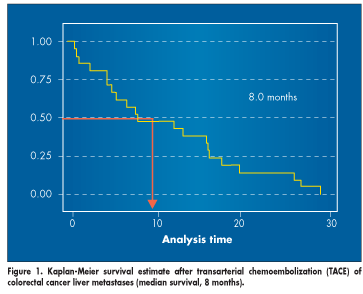Chemo/Radioembolization Both Effective for Liver Mets
Both chemoembolization and radioembolization are safe and confer a similar survival benefit of about 7 to 8 months in patients with liver-dominant metastases of colorectal cancer in the salvage setting
SEATTLEBoth chemoembolization and radioembolization are safe and confer a similar survival benefit of about 7 to 8 months in patients with liver-dominant metastases of colorectal cancer in the salvage setting, investigators reported at the 2007 Society of Interventional Radiology annual meeting (abstract 131).
Locoregional therapies have become increasingly attractive options for treating hepatic metastases and work in part by exploiting the dual blood supply of the liver, said lead author Kelvin Hong, MD, of the Johns Hopkins University School of Medicine. "Metastases derive arterial supply from the hepatic artery," he said; therefore, transarterial therapy can "bypass the first-pass effect, with maximum dwell time and minimization of systemic escape as well as toxicity."
The single-institution, retrospective study compared transarterial chemoembolization (TACE) with radioembolization in patients with liver-dominant metastatic colorectal cancer refractory to third-line chemotherapy. The study involved 36 consecutive patients: 21 were treated with chemoembolization (37 procedures; mean, 1.8 per patient) and 15 were treated with radioembolization (19 procedures; mean, 1.3 per patient), according to operator preference.
Chemoembolization was performed with cisplatin, doxorubicin, and mitomycin (Mutamycin) emulsified with lipiodol, along with polyvinyl alcohol particles and microspheres (Embospheres, BioSphere Medical, Rockland, Massachusetts). "The endpoint was stagnation of flow and not embolization," Dr. Hong noted.
Radioembolization was performed as a staged procedure. First, the visceral arterial supply was mapped angiographically, vessels posing a risk to nontarget GI structures were embolized, and a shunt study was performed. Then, in patients with acceptable study results, yttrium-90-tagged microspheres (TheraSpheres, MDS Nordion, Ottawa, Canada) were delivered at a mean dose of 113 Gy. All patients underwent laboratory, imaging, and clinical assessment after 4 to 6 weeks, with repeated treatment if necessary.
The majority of patients in both groups had Child-Pugh class A disease and had undergone resection of the primary tumor; a minority (20% to 23%) had previously undergone hepatic resection, Dr. Hong said. The median time between diagnosis and study treatment was 17.6 months for chemoembolization and 22.6 months for radioembolization. The median diameter of the dominant liver lesion was 9.3 cm and 8.2 cm, respectively. Some 33% to 43% of patients had extrahepatic disease, and the liver metastases were multilobar in 67% to 87% of cases.
All procedures were technically successful, Dr. Hong said. "Essentially all patients developed some element of a postembolization syndrome, but most were self-limiting with conservative measures," he said. "In the radioembolization group, patients certainly subjectively had milder side effectsfatigue was more prominentbut chemoembolization was associated with more pain." There was only one major complication (pulmonary embolism), occurring in the chemoembolization group. None of the patients had complications in nontarget gastrointestinal structures.
The 30-day mortality rate was 5.4% with chemoembolization (two deaths, from pulmonary embolism and disease progression) and 1.5% with radioembolization (one death, from disease progression).
Post-treatment Survival
Mean follow-up was 14.3 months after chemoembolization and 12.6 months after radioembolization. Median post-treatment survival was 8.0 months and 6.9 months, respectively, which was not a significant difference (see Figures 1 and 2). "Keep in mind this is in the salvage setting," Dr. Hong said. The groups also had similar rates of survival at 1 year (43% vs 34%) and 2 years (10% vs 18%).


Using EASL criteria, 70% of the chemoembolization group and 60% of the radioembolization group had an objective response to the treatment; using RECIST criteria, 10% of the radioembolization group had a response.
Putting the findings into perspective, Dr. Hong noted that median survival of patients with colorectal cancer refractory to chemotherapy is typically only 3 to 6 months, whereas this study and others suggest that value increases to 7 to 12 months with hepatic embolic therapies.
"We think locoregional targeted therapies can control liver progression and ultimately help improve survival, particularly since cause of death is frequently liver failure," he said. He stressed the need for further randomized, controlled studies, but underscored the difficulty of defining the control arm. "Failures of previous attempts at such studies have been due to the fact that the medical community can't decide among themselves on a control treatment group," he said.